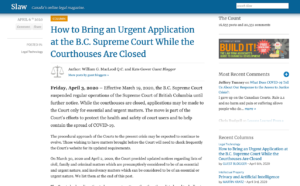Why We Won’t Go Back to Paper-Based Chambers Proceedings
The savings in time and money from virtual electronic or telephone hearings are too compelling to ignore. The COVID-19 crisis is going to make us save a lot of money by forcing us to conduct virtual Chambers applications!
Mostly the savings will come from not having to physically show up at the courthouse and to wait for your turn to be heard. This allows the lawyers to be productively engaged on other matters back at their offices, or for that matter anywhere there is a phone and good internet connection.
To consider the extent of the savings, I have used an hourly rate for the lawyer of $400 per hour and a typical opposed half hour civil Chambers application. compelling Some lawyers charge less, and some more, but whatever the legal rates and the length of the hearing, the financial savings from a virtual hearing are very substantial.
With a remote electronic hearing, lawyers do not have to pack up and travel to the courthouse for the hearing. For those close by the courthouse, this is perhaps only a twenty minute commute. For travel to the court from across the city this can be as much as an hour each way. Such travel charges may be explicitly covered in retainer agreements to be paid in full by the client. More commonly they are not fully charged to the client or if charged, on a review of a lawyer’s accounts, the time charges are reduced by half. E.g. Sokolowski v Lorne N. MacLean Law Corp. [2016] B.C.J. No. 1179 at paragraph 27-29. Thus either the client or the firm, or both absorb the cost of actually getting to the courthouse. For the sake of illustration, assume a half hour each way for packing up and travelling to the Court. At $400 per hour this comes to a charge to the client of $200.
Then a lawyer is supposed to check in with the Clerk of the Court at 9.45 am to confirm that the matter is proceeding and the time estimate for the hearing. ($80) Then after 10 am, lawyers must wait their turn to be heard. “First reading matters”, i.e. matters that are unopposed go first, and thus have shorter wait times. (In the case of these matters it needs to be examined whether these matters should require an appearance in court at all.) Then the contested matters are heard in order of their time estimates.
A typical half hour hearing may require an hour’s wait to be heard. It could be less or more. If the matter is not completed before the 15 minute morning break at or about 11.15 that time is added to the wait. Thus, after checking in, a lawyer can wait an hour and quarter for a typical half hour application. Such wait time is typically billed to the client at the hourly rate of the lawyer. At $400 per hour, this comes to $500.
The additional costs in this example come to about $780 per party, plus taxes at 12% which brings the cost to about $875 per party.
In addition the costs of the physical preparation of paper briefs may be avoided if the material is presented to the court electronically. For example a typical contested Chambers application with two parties might require ten tabs in a chambers brief and ten case authorities totalling say 100 pages. Three copies of the Chambers materials and authorities are needed. The typical charges for preparing the photocopies of this material are $.25 per page. This works out to about $75 for the photocopying. Add the costs of 3 binders ($30) and tabs ($15) and paralegal time (say an hour at $100) and this comes to $220. Again taxes at 12% apply to bring the savings to about $250.
Even if one assumes that these latter savings are divided between the two parties, on a fairly typical Chambers application the total savings from a remote hearing can easily be $1000 per party or more.
These estimates are conservative. They assume no prolonged delay from being heard on a crowded chambers list. If the delay due to the court calendar extends into the afternoon, the cost of time wasted can be significantly higher.
The electronic process for such applications may also free counsel from having to attend at their office on court days. With paper briefs, lawyers must typically go there to access photocopies, binders, tabs, paper punches, labels and the support staff to produce a final paper product. With an electronic process those accoutrements of the paper world can be jettisoned.
So, while no one would wish COVID-19 upon us, as a side effect and benefit, we may be forced to conduct hearings virtually and save money too.…
